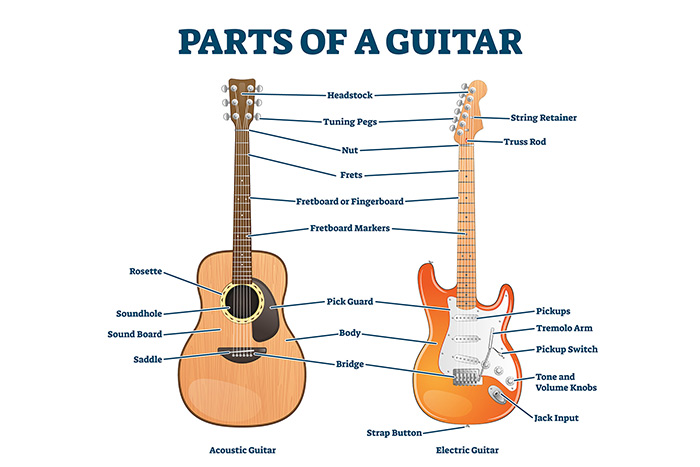The Beginnings Of The Guitar
Guitars have existed, in one way or another, for hundreds of years in many different shapes and sizes. To the eye of someone today, some of these instruments may not even look like the modern guitar, although they do play an important part in forming what would go on to be one of the most popular instruments of modern times.
The Arabic oud is an ancient cousin of the guitar that although still exists today, we can trace back to thousands of years ago. Similar looking to the lute which would come later, the Arabic oud was built in a teardrop shape with a rounded back, with 11 strings in a double stringing fashion like the modern 12-string guitar (one was a single string). Many instruments that were to follow would adapt this double stringing design, as this allowed for more projection and definition in the sound on the dull tone of the gut strings made from sheep intestines.
This instrument, like many others that would come after it, was played with an oud plectrum, which had a longer shape and would be wrapped between the fingers to pluck the strings, not all that dissimilar to the modern guitar plectrum. Unlike the modern guitar, the Arabic oud did not have any frets, allowing the player to access microtonal sounds not found in the 12 step Western scale. This instrument would prove to be extremely important to the guitar as we know it, as many of the instruments that would come after it would take inspiration from the design of the Arabic oud.
As people travelled to different regions with their instruments, locals of different parts of the world would create their own versions of these instruments played by foreigners which would create unique differences through different time periods and regions. This would lead to the Renaissance lute of the 1500’s (very similar to the Arabic oud with six pairs of strings, and moveable frets made from animal guts), the Renaissance guitar also of the 1500’s (which would later birth the ukulele when taken to Hawaii as it had the same tuning in double stringing), the Baroque guitar of the 1600’s (similar look to the renaissance guitar but bigger with five pairs of strings tuned a fourth lower to it’s predecessor), the 19th century guitar around 1800 (almost the guitar as we know it, but with friction pegs instead of tuning gears, and metal wound strings), to finally the classical guitar around 1850, which is basically unchanged to a modern classical guitar. When looking at images of all of these instruments, you can see the guitar slowly forming through each iteration whether it be from the body shape, stringing, or tuning.
The Move To A More Modern Look
In the early 1800’s classical guitar maker Stauffer took on a new apprentice while making guitars in Vienna named C.F. Martin, who many will know as the man who originally began Martin guitars, one of the more popular acoustic guitars of the modern day. C.F. Martin would go on to create the first iteration of the modern steel string guitar, taking what he had learnt in Vienna with the classical guitar and giving it steel strings for more volume and projection. Not only did he change the strings, but Martin also added an X bracing pattern in the inside of the body of the guitar, giving more support to hold the steel strings in and made the instrument overall much more durable. The body shape would go through many different versions under Martin’s catalogue, experimenting with making different sections bigger and smaller to change the sound and feel of the instrument. This would be the beginning of some of the flagship acoustic guitar shapes such as the dreadnought body shape.
The Electric Guitar
So in terms of the acoustic guitar, Martin hit the nail on the head and created a design that wouldn’t need changing right up until the modern day, but could the guitar stay acoustic? The early 20th century saw many experiment with the idea of making the guitar electric, as it was seen as more of a rhythm instrument at the time due to the fact that it just couldn’t be heard in a big band or ensemble setting. But guitarists really wanted to play solos without being drowned out by everyone else, so something had to be done!
1931 would see the first version of the electric guitar, which was a lap steel guitar dubbed as ‘the frying pan’. This looked just as the name suggests, and would become popular in Hawaiian music of the time played with a slide. The most important invention here was the contraption the frying pan used to detect the sound, which was the first version of the magnetic pickup. Guitar company Rickenbacker was manufacturing the frying pan at the time, and was quick to have the idea of adding this technology in to a regular fretted instrument. Shortly after the frying pan, they would then begin to release hollow body electric guitars that also contained the same magnetic pickup as the frying pan, on a body and neck more familiar to players of the time.
The Solid Body Electric Guitar
The issue with the hollow and semi-hollow bodied guitars was that they created unwanted feedback when played at volume. This led to builders such as Les Paul beginning to try and make a solid bodied instrument with ‘the log’, which would use similar pickup technology which a solid chunk of wood to create more sustain at high volumes without the unwanted feedback. Les went off the idea for a while after having no luck with a desirable design, the look of his instrument not being appealing to his audience or any buyers. The first solid body electric guitar available to purchase would come from Leo Fender of the infamous Fender guitars, with a model named the Esquire. The Esquire would be a predecessor to the Fender Telecaster (or as it was first known – the ‘Broadcaster’) with an almost identical body shape. The main difference however was that the Esquire only contained one pickup.
The release of the Esquire rekindled the idea of a solid body electric guitar in Les, leading to him designing the equally notable Les Paul solid body electric guitar, first sold by acoustic guitar manufacturer Gibson in 1952. Although the guitar would undergo some design changes to the pickups and bridge, like its competitor the Esquire the overall body shape and look of the Les Paul is very similar to what you can find hanging on the wall of your local guitar store today.












